Papers by Marcílio da Rocha Freitas
REM. Revista Escola de Minas, Jun 1, 2007
This work presents a study of welded gap K-and KT-joints formed by seamless steel hollow structur... more This work presents a study of welded gap K-and KT-joints formed by seamless steel hollow structural sections with rectangular hollow section for the chords and circular hollow section for the members. The study involves the generation, analysis and calibration of numerical models based on the finite element method, by comparison with experimental results previously obtained with full-scale prototypes. Several models were analyzed with shell elements, evaluating the radius of corner influence on the rectangular hollow section, as well as some modeling alternatives of the welds in the connections. The results of the computational analysis are in good agreement with the experimental results.
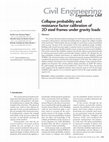
REM - International Engineering Journal, Sep 1, 2023
The current advanced analysis techniques for steel frames generally use structural analyses with ... more The current advanced analysis techniques for steel frames generally use structural analyses with geometric and material nonlinearities to capture the collapse strength of the steel frame. Unfortunately, the true strength of a steel frame cannot be predicted with accuracy because of the uncertainties of the most significant design variables. Building codes of steel structures apply a resistance factor to account for the uncertainties present in the design variables and thus ensure a target level of structural reliability. This article examines the reliability of planar steel frames subject to gravitational loads by advanced structural analysis (second-order inelastic analysis). To calculate the collapse probability of planar steel frames, we utilized the first-order reliability method (FORM). The advanced analyses were performed using the program MASTAN2 and considered the geometric nonlinearities and inelasticity of the steel. The collapse probabilities of planar steel frames were evaluated and the adequacy of the resistance factor applied was discussed. The current inelastic design procedure of ANSI 360 reduces the yield strength and stiffness of all members by a factor of 0.90. Thus, the present study suggests that the adopted resistance factor must be equal to 0.85 for the target reliability index equal to 3.0, or it must be equal to 0.69 for the target reliability index equal to 3.8.
Editora Científica Digital eBooks, 2022
Todo o conteúdo deste livro está licenciado sob uma Licença de Atribuição Creative Commons. Atrib... more Todo o conteúdo deste livro está licenciado sob uma Licença de Atribuição Creative Commons. Atribuição 4.0 Internacional (CC BY 4.0). O conteúdo dos artigos e seus dados em sua forma, correção e confiabilidade são de responsabilidade exclusiva dos autores. Permitido o download da obra e o compartilhamento desde que sejam atribuídos créditos aos autores, mas sem a possibilidade de alterá-la de nenhuma forma ou utilizá-la para fins comerciais.
A fatigue analysis of the welded tubular joints in a metallic trussed bride is presented herein. ... more A fatigue analysis of the welded tubular joints in a metallic trussed bride is presented herein. The fatigue life of these joints was achieved be means of geometric and nominal stress methods established by the CIDECT 8 (2000) and Eurocode 3 (2005) standards, with an approach based on tension cycles (curves S-N). In addition, a comparative discussion of these two methods is presented; their advantages, limitations, etc. The results demonstrate which method is best applicable for the given situation of the project.
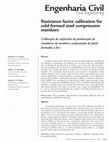
REM. Revista Escola de Minas, Jun 1, 2013
O objetivo desse artigo é apresentar uma revisão do procedimento de calibração do coeficiente de ... more O objetivo desse artigo é apresentar uma revisão do procedimento de calibração do coeficiente de ponderação da resistência para um dado índice de confiabilidade alvo. Coeficientes de ponderação da resistência, para colunas de perfis formados a frio, são calculados com um método de confiabilidade de primeira ordem e segundo momento. Foi montado um banco de dados com 323 ensaios de colunas de perfis formados a frio, carregadas, concentricamente, com seções U e U enrijecido, e foram obtidas estatísticas para a relação carga de ensaio versus carga predita para os três métodos disponíveis na Norma Brasileira para perfis formados a frio: o Método da Largura Efetiva (MLE), o Método da Seção Efetiva (MSE) e o Método da Resistência Direta (MRD). Para a combinação de carga normal, relação carga permanente / carga variável de 1/3 e índice de confiabilidade alvo b o = 2.5, os coeficientes de ponderação da resistência calculados para os três métodos são consistentes com o valor especificado pela Norma Brasileira. Para todos os métodos, com o índice de confiabilidade alvo b o = 3.0, os coeficientes de ponderação da resistência calculados são maiores que os especificados pela Norma Brasileira.
REM. Revista Escola de Minas, Mar 1, 2004
Sistemas de armazenagem industrial são amplamente utilizados em todo o mundo, pois aliam praticid... more Sistemas de armazenagem industrial são amplamente utilizados em todo o mundo, pois aliam praticidade e economia. Eles possuem diversas particularidades estruturais, entre elas a existência de perfurações ao longo da altura das colunas, para encaixe de outros elementos, o que dificulta a previsão de sua resistência, devendo esta ser feita, segundo associações de fabricantes, por meio de ensaios. Esse trabalho apresenta a utilização da simulação via elementos finitos para previsão da resistência dessas colunas e nele também são apresentadas alternativas aos ensaios experimentais.
REM - International Engineering Journal, Jul 1, 2018
This article shows a study of the level of reliability of welded and bolted connections in cold f... more This article shows a study of the level of reliability of welded and bolted connections in cold formed steel members, for some limiting states, adopted by AISI and Brazilian codes. The aim of this study is the assessment of the reliability index β for a variation of the nominal live-to-dead load ratios as well as comparison of the value found considering different load combinations. The first order reliability method is used to calculate the reliability index β. In this study, reliability indices smaller than 3.5 were obtained, especially for bolted connections. Consideration of the model errors and FORM method, lead to significant reductions in reliability indices, which are found to be less than the recommended target reliability levels.
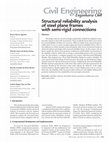
REM - International Engineering Journal, Jul 1, 2018
The design codes for structural design traditionally establish the adoption of partial safety fac... more The design codes for structural design traditionally establish the adoption of partial safety factors to deal with uncertainties. These standards do not allow one to know the real probabilities of failure of a structure. What is needed, from a practical and scientific point of view, is a more consistent approach, based on reliability theory. This article addresses an initial attempt at determining the safety levels of structures based on advanced analysis and design with structural reliability theory. In this context, the authors consider the effects of the geometric nonlinearity and flexibility of connections in the reliability analysis, which aims at setting a certain displacement as the service limit state. For this purpose, a computer program was written called Structural Reliability Module. This program uses a First Order Reliability Method to analyse reliability. To carry out the structural analysis of steel structures, this study uses the program Computational System for Advanced Structural Analysis. Validating the Structural Reliability Module involved comparing the results from other authors with those generated by the program. Results for the structures under study indicate the efficiency of the implemented measures. Results suggest that, when a certain displacement is set as a service limit state, the reliability of the structures under analysis are only slightly influenced by geometric nonlinearity but considerably so by semi-rigid connections.

Revista Ingeniería de Construcción, 2021
Cold-formed Steel profiles are structural profiles widely used in civil construction. They are of... more Cold-formed Steel profiles are structural profiles widely used in civil construction. They are often manufactured with perforations. The designing can be performed using the direct resistance method. Formulations were adapted by Moen and Schafer (2008) to consider the presence of perforations in these profiles. The objective of this study is to investigate the structural safety of columns with web perforations. The calculation of the resistance capacity was performed using the formulations proposed by the authors. The reliability indexes were determined using the First Order Reliability Method (FORM), First Order Second Moment (FOSM) and Monte Carlo Method (MCM), which are reliability methods for the Load and Resistance Factor Design (LRFD) and Limit States Design (LSD) philosophies. Following the same criteria performed by AISI S100, the resistance factors were obtained from the FOSM method. Based on the results, it was found that the desired security level for the LSD philosophy was not achieved. The calculated resistance factors are predominantly lower than the target. However, for the LRFD philosophy, the safety level was achieved, and the resistance factors were higher than the target.
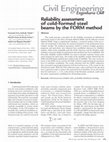
REM - International Engineering Journal, Jun 1, 2021
This article presents a procedure for the reliability assessment of cold-formed steel beams based... more This article presents a procedure for the reliability assessment of cold-formed steel beams based on the Direct Strength Method (DSM) and the Effective Section Method (ESM). Using a comprehensive database, a statistical analysis of the test results was performed to determine the statistical properties of the professional factor random variable. The statistical parameters related to material strength, geometric properties and load effects were obtained from established references for reliability analysis. Safety levels compatible with the North American and the Brazilian codes relating to structural design of cold-formed steel members have been established. The first-order reliability method (FORM) was used to calculate resistance factors φ for usual nominal live-dead ratios. The results of the reliability analysis showed that the DSM and ESM design methods have similar levels of reliability. The same resistance factor as the DSM can be used for the ESM, without compromising the minimum level of reliability established. The results obtained with the LRFD calibration data, presented a good approximation with the load factor φ = 0.90, except for the distortional mode. With the LSD calibration data, values well below the specified were required in order to achieve the required level of reliability. It was also found that the load factor γ = 1.25, in the format of the Brazilian standard, could reach the safety requirements established for all buckling modes.
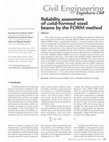
REM - International Engineering Journal
This article presents a procedure for the reliability assessment of cold-formed steel beams based... more This article presents a procedure for the reliability assessment of cold-formed steel beams based on the Direct Strength Method (DSM) and the Effective Section Method (ESM). Using a comprehensive database, a statistical analysis of the test results was performed to determine the statistical properties of the professional factor random variable. The statistical parameters related to material strength, geometric properties and load effects were obtained from established references for reliability analysis. Safety levels compatible with the North American and the Brazilian codes relating to structural design of cold-formed steel members have been established. The first-order reliability method (FORM) was used to calculate resistance factors φ for usual nominal live-dead ratios. The results of the reliability analysis showed that the DSM and ESM design methods have similar levels of reliability. The same resistance factor as the DSM can be used for the ESM, without compromising the minimum level of reliability established. The results obtained with the LRFD calibration data, presented a good approximation with the load factor φ = 0.90, except for the distortional mode. With the LSD calibration data, values well below the specified were required in order to achieve the required level of reliability. It was also found that the load factor γ = 1.25, in the format of the Brazilian standard, could reach the safety requirements established for all buckling modes.
Proceedings of the XXXVIII Iberian Latin American Congress on Computational Methods in Engineering, 2017
Sao apresentados metodos de calculo para a previsao da vida residual sob fadiga de elementos estr... more Sao apresentados metodos de calculo para a previsao da vida residual sob fadiga de elementos estruturais de plataformas oceânicas levando em conta o carater aleatorio dos parâmetros envolvidos e com base na mecânica da fratura. Os procedimentos sao baseados na caracterizacao dos estados de mar, na simulacao do carregamento aleatorio, na analise da resposta dinâmica da estrutura sujeita a carregamento ambiental, na contagem dos ciclos de solicitacao pelo metodo rainflow, na avaliacao da vida sob fadiga por analise de acumulo de dano, na avaliacao da vida sob fadiga por analise de propagacao de trinca. A previsao da vida sob fadiga baseada na curva S-N e utilizada para fins de comparacao com os resultados dos procedimentos baseados na mecânica da fratura. A validade dos procedimentos apresentados e analisada na predicao da vida sob fadiga de um cilindro engastado no leito do oceano.

Models for determining the reliability of a pressure vessel have been target of various studies b... more Models for determining the reliability of a pressure vessel have been target of various studies based on Probabilistic Fracture Mechanics (PFM). Generally catastrophic failures in pressure vessel such as spherical storage tanks have influenced and motivated research that aims to improve tank durability and consequently its security, with the possibility of making it more economical for the petrochemical industry. As an objective of providing a better method for the evaluation of this problem, a model was designed and is presented herein that estimates the reliability of spherical pressure vessels for storage of Liquid Petroleum Gas (LPG). This model applies probabilistic fracture mechanics. To achieve this, all the important variables were determined and then, this data bank adjusted the acceptable probability distribution. This procedure established a failure mode and evaluated the reliability of pressure vessels under the adopted conditions. To process this data, a method generate...
Proceedings of the XXXVI Iberian Latin American Congress on Computational Methods in Engineering, 2015

labciv.eng.uerj.br
Industrial Storage Systems are usually built with cold-formed profiles. Their sections, called "r... more Industrial Storage Systems are usually built with cold-formed profiles. Their sections, called "rack sections", are specially designed with perforations to accommodate connections and bolts for easy assemblage. This, however, induces unexpected failure modes in other sections. The aim of this research was to analyze the effects of perforations on column behavior and resistance using the commercial software ANSYS and the finite element method. The numerical values for this procedure were previously obtained using the finite strip method and the generalized beam theory. These results were then calibrated by comparing them to the finite element models of columns without perforation. The element type, mesh refinement and boundary conditions were carefully chosen to ensure that the finite element model reproduces actual column behavior. The finite element model was used to evaluate the effects of perforation size, quantity and distribution on column behavior.
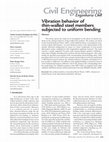
REM - International Engineering Journal, Jul 1, 2018
This article reports the results of an investigation on the effects of internal moments on the vi... more This article reports the results of an investigation on the effects of internal moments on the vibration behavior of thin-walled steel members. The analyses are based on the Generalized Beam Theory (GBT), a thin-walled bar theory accounting for crosssection in-plane deformations-its main distinctive feature is the representation of the member deformed configuration by means of a linear combination of cross-section deformation modes, multiplied by their longitudinal amplitude functions. The study concerns a simply supported T-section (with unequal flanges) members exhibiting a wide range of lengths and subjected to uniform internal moment diagrams-their magnitudes are specified as percentages of the corresponding critical buckling values. After providing a brief overview of the main concepts and procedures involved in performing a GBT-based structural analysis, the vibration behavior of load-free and loaded T-section members is addressed-the influence of the applied loadings is assessed in terms of (i) the fundamental frequency difference and (ii) the change in the corresponding vibration mode shape. For validation purposes, some GBT results are compared with values yielded by shell finite element analysis performed in the code ABAQUS (Simulia, 2008).
Engenharias: Pesquisa, desenvolvimento e inovação 3, Jan 18, 2023
Editora Direitos para esta edição cedidos à Atena Editora pelos autores. Open access publication ... more Editora Direitos para esta edição cedidos à Atena Editora pelos autores. Open access publication by Atena Editora Todo o conteúdo deste livro está licenciado sob uma Licença de Atribuição Creative Commons. Atribuição-Não-Comercial-NãoDerivativos 4.0 Internacional (CC BY-NC-ND 4.0).
Proceedings of the XXXVIII Iberian Latin American Congress on Computational Methods in Engineering, 2017

Uploads
Papers by Marcílio da Rocha Freitas